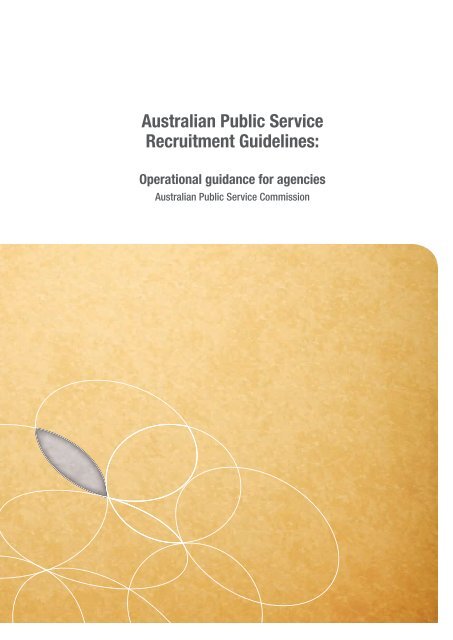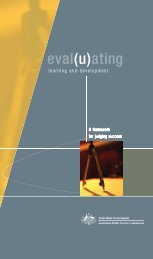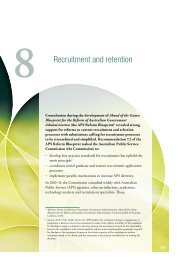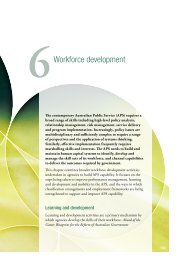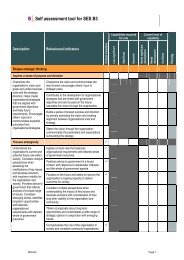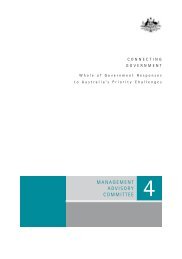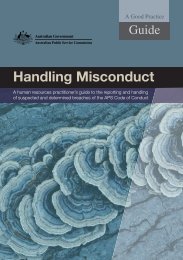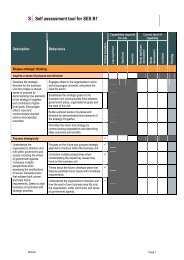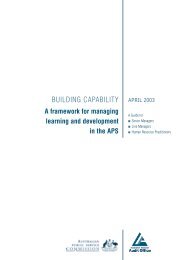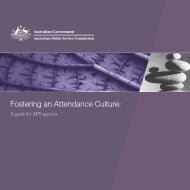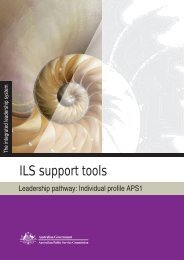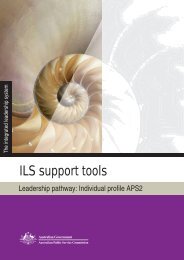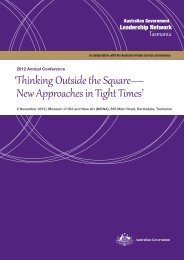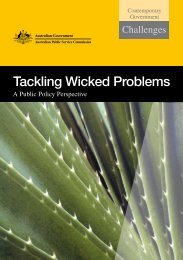APS Recruitment Guidelines - Australian Public Service Commission
APS Recruitment Guidelines - Australian Public Service Commission
APS Recruitment Guidelines - Australian Public Service Commission
Create successful ePaper yourself
Turn your PDF publications into a flip-book with our unique Google optimized e-Paper software.
<strong>Australian</strong> <strong>Public</strong> <strong>Service</strong><br />
<strong>Recruitment</strong> <strong>Guidelines</strong>:<br />
Operational guidance for agencies<br />
<strong>Australian</strong> <strong>Public</strong> <strong>Service</strong> <strong>Commission</strong>
Message from the <strong>Commission</strong>er<br />
<strong>Recruitment</strong>, be it engagement, promotion or movement of existing <strong>APS</strong> employees, underpins the<br />
integrity and performance of the <strong>Australian</strong> <strong>Public</strong> <strong>Service</strong> (<strong>APS</strong>). Processes that support recruiting<br />
the right employees represent a key step in ensuring the <strong>APS</strong> is representative of the people we serve<br />
and effective in administering our responsibilities.<br />
I welcome the publication of the <strong>APS</strong> <strong>Recruitment</strong> <strong>Guidelines</strong> which provides recruiters at all levels<br />
with a best practice guide to support the good work already taking place across agencies.<br />
The overarching goal of the guidelines is to provide a resource that is easy to use, practical and one<br />
that explains the highly involved recruitment process.<br />
This guide is designed for ease of use whilst still being a comprehensive guide for recruiters. It<br />
provides guidance on tailoring recruitment processes to achieve greater efficiency while maintaining<br />
transparency and agency autonomy.<br />
The guideline’s key aims are to:<br />
• ensure the principle of merit is upheld<br />
• dispel some widespread myths about the recruitment process<br />
• build capacity<br />
• encourage agencies to consider alternative recruitment processes.<br />
I thank the agencies that have contributed to the development of these guidelines and trust you will<br />
find them valuable and informative, enabling your agency to continuously improve its recruitment<br />
processes and to find the right people for the right job.<br />
Stephen Sedgwick AO<br />
<strong>Australian</strong> <strong>Public</strong> <strong>Service</strong> <strong>Commission</strong>er<br />
ii
Table of Contents<br />
Message from the <strong>Commission</strong>er.................................................................................................ii<br />
Introduction..................................................................................................................................v<br />
Scope of the guidelines...............................................................................................................vi<br />
Stage 1 - Planning..........................................................................................................................1<br />
Overview......................................................................................................................................2<br />
Roles and responsibilities.............................................................................................................2<br />
Job analysis.................................................................................................................................4<br />
Writing a job description...............................................................................................................6<br />
Defining other work-related requirements for the job....................................................................7<br />
Workforce diversity.......................................................................................................................9<br />
Other planning considerations....................................................................................................11<br />
Administration............................................................................................................................13<br />
Options to fill a vacancy..............................................................................................................15<br />
Stage 2 - Sourcing........................................................................................................................17<br />
Overview....................................................................................................................................18<br />
<strong>APS</strong> Redeployment Register.......................................................................................................18<br />
Attracting applicants...................................................................................................................18<br />
Accessibility issues.....................................................................................................................19<br />
Notifying the employment opportunity........................................................................................19<br />
Developing selection criteria.......................................................................................................20<br />
Existing orders of merit...............................................................................................................20<br />
Stage 3 - Assessing......................................................................................................................23<br />
Overview....................................................................................................................................24<br />
The merit principle.....................................................................................................................24<br />
Work-related qualities................................................................................................................24<br />
Selection panels.........................................................................................................................24<br />
Short-listing...............................................................................................................................25<br />
Stage 4 – Selecting......................................................................................................................27<br />
Overview....................................................................................................................................28<br />
Recommending preferred applicant............................................................................................28<br />
Selection report..........................................................................................................................28<br />
Delegate decision.......................................................................................................................28<br />
Secondary considerations...........................................................................................................29<br />
Providing feedback to unsuccessful applicants...........................................................................29<br />
<strong>Australian</strong> <strong>Public</strong> <strong>Service</strong> <strong>Recruitment</strong> <strong>Guidelines</strong>: Operational guidance for agencies<br />
iii
Stage 5 – On-boarding.................................................................................................................31<br />
Overview....................................................................................................................................32<br />
Contacting successful applicant and making the employment offer............................................32<br />
Notifying the outcome in the <strong>APS</strong> Employment Gazette...............................................................33<br />
Induction....................................................................................................................................33<br />
Probation....................................................................................................................................34<br />
Cancelling an employment decision............................................................................................34<br />
<strong>Recruitment</strong> Performance Measures............................................................................................35<br />
Overview....................................................................................................................................36<br />
Direct cost of recruitment activities............................................................................................36<br />
Quality of recruitment outcomes.................................................................................................36<br />
Quality of recruitment processes................................................................................................37<br />
Improved applicant experience...................................................................................................37<br />
References...................................................................................................................................38<br />
iv
Introduction<br />
The <strong>APS</strong> <strong>Recruitment</strong> <strong>Guidelines</strong> (the guidelines) provide <strong>APS</strong> agencies with information<br />
to tailor recruitment processes to achieve greater efficiency, preserve transparency and open<br />
competition while upholding the principle of merit.<br />
The guidelines encourage agencies to continue to be autonomous and flexible when managing<br />
their recruitment processes within the boundaries of legislation while providing consolidated<br />
information and guidance modelled on best practice. They provide human resource practitioners<br />
and <strong>APS</strong> managers with:<br />
• links to relevant legislation<br />
• agency case studies<br />
• facts to dispel recruitment myths<br />
• a Manager’s Toolkit (toolkit).<br />
The guidelines are to be used in conjunction with the <strong>Australian</strong> <strong>Public</strong> <strong>Service</strong> <strong>Commission</strong><br />
(<strong>APS</strong>C) publication <strong>Recruitment</strong> and selection in the <strong>APS</strong> which details the legislative and<br />
policy framework applying to recruitment. The guidelines are structured around the five stages of<br />
a recruitment process:<br />
• planning<br />
• sourcing<br />
• assessing<br />
• selecting<br />
• on-boarding.<br />
Table 1: Relationship of guidelines to <strong>Recruitment</strong> and selection in the <strong>APS</strong><br />
<strong>APS</strong> <strong>Recruitment</strong> <strong>Guidelines</strong><br />
<strong>Recruitment</strong> and selection in the <strong>APS</strong><br />
Stage 1 - Planning Step 1: identify employment opportunity, category and<br />
classification and whether vacancy needs to be filled<br />
Step 2:<br />
Step 3:<br />
decide how vacancy is likely to be filled (i.e.<br />
engagement of new employees or promotion or<br />
movement of existing employees)<br />
develop supporting documentation<br />
Stage 2 - Sourcing Step 4: decide what notification is required (i.e. is gazettal<br />
needed?)<br />
Step 5:<br />
Step 6:<br />
Stage 3 - Assessing Step 7: accept applications<br />
Step 8:<br />
decide if opportunity is to be open to all eligible<br />
members of the community<br />
notify in the gazette—additional advertising optional<br />
assess relative suitability of candidates<br />
Stage 4 - Selecting Step 9: recommend preferred candidate on basis of relative<br />
merit<br />
Step 10: delegate makes selection decision<br />
Stage 5 - On-boarding<br />
Step 11: implement decision<br />
<strong>Australian</strong> <strong>Public</strong> <strong>Service</strong> <strong>Recruitment</strong> <strong>Guidelines</strong>: Operational guidance for agencies<br />
v
The guidelines also include performance measures that can be applied to recruitment which can drive<br />
greater accountability for recruitment, encourage staff to plan and implement efficient recruitment<br />
processes and provide agencies with data to inform continuous improvement.<br />
Scope of the guidelines<br />
The guidelines apply to <strong>APS</strong> Level and Executive Level recruitment processes for:<br />
• ongoing employment opportunities<br />
• non-ongoing opportunities for a specified term of more than 12 months<br />
• non-ongoing opportunities for a specified task reasonably estimated to take more than<br />
12 months.<br />
The following topics are not covered by the guidelines because they are covered by other <strong>APS</strong>C policy<br />
and guidelines:<br />
• Senior Executive <strong>Service</strong> recruitment<br />
• agency head and statutory office holder selection<br />
• non-ongoing employment for 12 months or less<br />
• workforce planning<br />
ion<br />
dy<br />
www.apsc.gov.au/publications-and-media/current-publications/merit-and-transparency<br />
kit<br />
<strong>APS</strong>C website:<br />
www.apsc.gov.au/publications-and-media/current-publications/the-senior-executive-serviceselection-mobility-and-separation<br />
www.apsc.gov.au/publications-and-media/current-publications/recruitment-and-selection-inthe-aps<br />
tip<br />
www.apsc.gov.au/publications-and-media/current-publications/workforce-planning-guide<br />
vi
Roles and responsibilities<br />
Job analysis<br />
Writing a job description<br />
Defining other work-related requirements for the job<br />
Workforce diversity<br />
Other planning considerations<br />
Administration<br />
Options to fill a vacancy<br />
Planning
tip<br />
Overview<br />
<strong>Recruitment</strong> is the process of having the right person in the right place at the right time. It is crucial<br />
to organisational performance in the <strong>APS</strong>. <strong>Recruitment</strong> is a critical activity, not just for the human<br />
resources area but also for line managers increasingly involved in the selection process.<br />
As with any other important project, recruitment needs to be thoroughly considered, planned and<br />
appropriately resourced. A well-planned recruitment process is more likely to result in selecting the<br />
applicant/s that best fit the job.<br />
<strong>Recruitment</strong> processes vary and each has its own considerations and requirements. It is important for<br />
everyone involved in recruitment to be equipped with the knowledge and skills needed to undertake<br />
their respective roles.<br />
A well run recruitment process reflects positively on the agency and the <strong>APS</strong> as a whole. In a<br />
competitive labour market it is important that applicants consider the <strong>APS</strong> as an employer of choice.<br />
An applicant’s perception of the <strong>APS</strong> can be influenced through participation in efficient and<br />
transparent recruitment.<br />
From a strategic perspective, each agency should consider how the planning stage can help achieve:<br />
• more timely and efficient recruitment processes<br />
• well defined job requirements that attract applicants who are the ‘best fit’ for the role<br />
and agency<br />
• greater ‘buy in’ to recruitment from managers and employees, including a greater willingness<br />
to assist in the process (e.g. as a selection panel member)<br />
• greater diversity of applicants, allowing the <strong>APS</strong> to better serve the diverse <strong>Australian</strong><br />
community.<br />
From an operational perspective, a well-planned recruitment process should consider:<br />
• gaining the delegate’s approval to commence the process<br />
• gaining the delegate’s approval at the end of the planning stage<br />
• establishing the required start date for the successful applicant<br />
• scheduling assessment activities, such as short-listing applicants, interviewing and contacting<br />
referees (if needed)<br />
• ensuring the availability and commitment of each selection panel member<br />
• securing an appropriate and accessible venue for selection activities<br />
• budgeting impacts if applicants need to travel to attend selection activities (which may depend<br />
on the agency’s Enterprise Agreement)<br />
• providing applicants with reasonable notice if they are to attend selection activities.<br />
Roles and responsibilities<br />
This section explains the roles that may be involved in the recruitment process.<br />
ion<br />
While there is no legislative requirement to form a selection panel, in most <strong>APS</strong> agencies a selection<br />
panel is formed and tasked with the responsibility of assessing the suitability of applicants.<br />
ion dy<br />
Stage 3 - Assessing section of the guidelines<br />
kit<br />
dy<br />
Information Sheet - Selection panel composition<br />
kit<br />
2
Role of the delegate<br />
The delegate is delegated employer powers by the agency head. The delegate is responsible for<br />
making the selection decision, and is accountable for ensuring that selection processes and<br />
decisions comply with merit requirements.<br />
Agencies may decide to have the delegate solely responsible for assessing applications and<br />
employment decisions, although this is rare.<br />
The delegate may be part of the selection panel, although some <strong>APS</strong> agencies have internal<br />
policies specifying that the delegate cannot be part of such a panel to ensure impartiality and<br />
avoid any perception of patronage or favouritism.<br />
In many cases an agency may require the delegate to approve the request for recruitment. This<br />
may include ensuring that the employment opportunity is correctly notified and endorsing<br />
selection documentation and assessment methods.<br />
information<br />
<strong>APS</strong>C website:<br />
www.apsc.gov.au/publications-and-media/current-publications/delegations-under-thepublic-service-act-1999-and-subordinate-legislation<br />
case study<br />
tool kit<br />
tip<br />
Role of the chairperson<br />
The chairperson is responsible for leading the selection process and managing the selection panel<br />
(if one is used). This may include overseeing panel composition and administrative requirements<br />
such as scheduling assessment activities and procuring scribe services (if one is used).<br />
Many agencies require the chairperson to complete specific training before assuming these<br />
duties.<br />
information<br />
case study<br />
tool kit<br />
tip<br />
Role of the selection panel member<br />
There are no legislative requirements on the number of people to be on a selection panel, nor the<br />
classification of panel members or gender balance. Each selection panel member is responsible<br />
for assisting in assessing the suitability of applicants for the role advertised.<br />
Many agencies require selection panel members to complete specific training before assuming<br />
selection panel duties.<br />
Role of the scribe<br />
There is no requirement for a scribe to be used in <strong>APS</strong> recruitment processes.<br />
A scribe is designated to document the recruitment process. A scribe can be asked to be a<br />
member of the selection panel, although this is not usual practice.<br />
Having a scribe can allow selection panel members to focus on assessment activities rather than<br />
on taking notes. A scribe can also draft the selection report more quickly, if they have been<br />
specifically designated for that role and are therefore able to give it a high priority.<br />
A scribe can be an <strong>APS</strong> employee, an <strong>APS</strong>C <strong>Recruitment</strong> Advisor or an external recruitment<br />
service provider.<br />
<strong>Australian</strong> <strong>Public</strong> <strong>Service</strong> <strong>Recruitment</strong> <strong>Guidelines</strong>: Operational guidance for agencies | 1: Planning<br />
3
ation<br />
study<br />
ol kit<br />
tip<br />
Role of the contact officer<br />
A contact officer must be identified for each vacancy notified in the <strong>APS</strong> Employment Gazette.<br />
This officer should be able to respond to queries from potential applicants regarding:<br />
• duties to be performed<br />
• work-related qualities required<br />
• background information and context about the role and agency<br />
• reporting structure<br />
• where the work will be undertaken<br />
• special requirements of the job—shift work, peak work periods, part time or full time<br />
• reasonable adjustments for people with disability that can be put in place in relation to the<br />
selection process.<br />
Contact officers are often the applicant’s first contact with the agency and it is important that they<br />
be available, professional and friendly, with a good understanding of the role and an ability to convey<br />
relevant information to applicants.<br />
The <strong>APS</strong>C offers the ‘Getting that selection right’ training program for any <strong>APS</strong> employee that has<br />
been or is likely to be selected for a recruitment selection panel. The program aims to achieve quality<br />
recruitment outcomes in line with <strong>APS</strong> merit-based assessment requirements.<br />
It is good practice to ensure the contact officer is not acting in the role being filled and is<br />
not a potential applicant. This removes any conflict of interest or perception of patronage or<br />
favouritism.<br />
The applicant<br />
The applicant (or candidate) is a person who has submitted a formal job application for assessment.<br />
ion<br />
ation<br />
<strong>APS</strong>C website:<br />
www.apsc.gov.au/learn/programs/human-resourcespeople-management/getting-that-selectionright<br />
dy<br />
study<br />
kit<br />
ol kit<br />
tip<br />
tip<br />
Job analysis<br />
Job analysis is the process used to collect information about the duties, responsibilities, necessary<br />
skills, essential qualifications, personal attributes and work environment relevant to a job.<br />
The process can assist in preparing selection documentation and identifying work-related qualities for<br />
the job.<br />
Investing time in job analysis increases the likelihood of attracting, selecting and retaining the<br />
best person.<br />
4
Job definition<br />
A number of triggers can lead to a recruitment process, including an employee leaving,<br />
a restructure, the expansion of a product or service or a new policy or program leading to the<br />
creation of new jobs.<br />
Re-using existing job documentation can be tempting and a quick option for those involved<br />
in recruitment, but agencies will benefit from reviewing previous documentation and accurately<br />
defining the role to be filled. Changes to the role and tasks involved since the original job<br />
description was written should be considered and incorporated.<br />
The recruiting manager should consider restructuring or re-allocating particular tasks and<br />
functions, as this may result in more efficient processes or present an opportunity for existing<br />
staff to benefit by:<br />
• gaining wider experience<br />
• developing new skills<br />
• experiencing an increased variety of tasks<br />
• participating in job-sharing opportunities<br />
• increasing hours of part-time staff<br />
• increasing flexibility of hours.<br />
The manager should also consider if the:<br />
• job is still necessary<br />
• duties need to be performed in the same way or be amended<br />
• classification is appropriate for the duties given the agency’s work level standards or<br />
whether the role should be re-classified<br />
• scope is right for new duties —(location of the job; reporting structure etc)<br />
• duties could be assigned to an existing employee on an ongoing or temporary basis<br />
• introduction of alternative working methods could reduce workload and/or improve<br />
service quality<br />
• job is likely to change in the foreseeable future<br />
• job lends itself to flexible working arrangements, for example whether it could be filled<br />
on a part time basis<br />
• job could be best performed by an Aboriginal or Torres Strait Islander person, and<br />
therefore could be advertised as a special measure<br />
• job could be performed by a person with intellectual disability, and therefore could be<br />
advertised as a special measure.<br />
information<br />
case study<br />
This information can be gathered through internal reports, performance agreements observation<br />
(e.g. what tasks are performed and how long is spent on them), questionnaires and/or interviews.<br />
The analysis of this information should form the basis of a job description and work-related<br />
qualities specification.<br />
Agencies should also consider if the job could be performed by a person with intellectual<br />
disability who cannot compete in a competitive selection process. If this is the case, special<br />
measures can apply.<br />
tool kit<br />
Information sheet - Recruiting people with an intellectual disability<br />
tip<br />
Template - Job analysis<br />
<strong>Australian</strong> <strong>Public</strong> <strong>Service</strong> <strong>Recruitment</strong> <strong>Guidelines</strong>: Operational guidance for agencies | 1: Planning<br />
5
Job description<br />
A job description describes what the person in the job is expected to do. It is a picture of the purpose,<br />
scope, tasks, duties and responsibilities of the job.<br />
Examples of how an accurate job description benefits the recruitment process are listed below:<br />
• provides the information to prepare the <strong>APS</strong> Employment Gazette employment opportunity<br />
notification and other advertisements<br />
• helps identify selection techniques<br />
• ensures employment decisions are based on merit and the work-related qualities required to<br />
do the job and minimise the possibility of patronage and favouritism<br />
• highlights the expected standard of work to employees and management to help ensure<br />
effective performance in the job<br />
• provides potential applicants with correct and relevant information<br />
• identifies the key skills required to do the job<br />
The most effective job descriptions detail the key results to be achieved rather than just listing tasks<br />
to be undertaken.<br />
While job descriptions can be presented in many ways, it is recommended that they include the<br />
following information:<br />
Job context<br />
• title, classification and salary range<br />
• role of the branch and group in the agency as well as overarching information about<br />
the agency<br />
• where the job fits in the reporting structure (who it is responsible to and for)<br />
• job location.<br />
Job summary<br />
• brief description of why the job exists<br />
• job responsibilities and a list of duties<br />
• a brief explanation of the main duties and priority result areas.<br />
Writing a job description<br />
Job descriptions should only reflect the essential or inherent requirements of the job and not<br />
unnecessarily exclude potential applicants.<br />
The following is an example of how to improve job descriptions based on the inherent requirements<br />
of the job and writing them in a way which is inclusive of the community:<br />
must have drivers licence<br />
ability to scribe shorthand<br />
must have knowledge of the department’s<br />
quality control strategies<br />
ability to travel extensively<br />
ability to record meetings<br />
have an understanding of quality assurance frameworks<br />
6
Identifying the role’s inherent requirements involves analysing what a person is being hired<br />
to do, rather than prescribing how a job is done.<br />
Firstly identify and list the main activities to be carried out.<br />
After identifying activities, group them and consolidate to ensure not too many are listed.<br />
Job descriptions should not be too lengthy and in most cases need no more than six to eight<br />
headings.<br />
Then define each activity as a statement of what the employee is expected to achieve and deliver<br />
on - in effect the output. This can be done in one sentence, beginning with a verb, in line with<br />
the examples below:<br />
• drafts<br />
• plans<br />
• tests<br />
• manages<br />
• schedules.<br />
Describe the object of the verb (what is done) as briefly as possible, in line with the examples<br />
below:<br />
• drafts ministerial correspondence<br />
• plans a stakeholder management strategy<br />
• tests new Information Technology systems<br />
• manages a small team<br />
• schedules Information Technology change releases.<br />
State briefly the purpose of the activity in terms of outputs or standards to be achieved, in line<br />
with the example below:<br />
Manages a small team to organise mail and deliver records to the Secretary’s office in accordance<br />
with departmental standards.<br />
Defining other work-related requirements for the job<br />
Agencies should consider the following issues early so they can be included in planning processes<br />
as appropriate.<br />
Essential qualifications<br />
Agencies may require people to hold certain qualifications, such as academic or technical<br />
qualifications or certification from a professional body.<br />
Examples of essential qualifications include:<br />
• registration as a medical practitioner for medical roles<br />
• a law degree and eligibility to be admitted to practice in a state or territory of Australia<br />
for legal roles<br />
• an undergraduate degree for entry into a graduate development program.<br />
Attaining and verifying essential qualifications can be imposed as a condition of engagement.<br />
information<br />
<strong>APS</strong>C website:<br />
www.apsc.gov.au/publications-and-media/current-publications/conditions-of-engagement<br />
case study<br />
<strong>Australian</strong> <strong>Public</strong> <strong>Service</strong> <strong>Recruitment</strong> <strong>Guidelines</strong>: Operational guidance for agencies | 1: Planning<br />
7
tion<br />
tudy<br />
l kit<br />
Information sheet - Essential qualifications<br />
tip<br />
Citizenship<br />
There is a general expectation that a person to be engaged as an <strong>APS</strong> employee will be an <strong>Australian</strong><br />
citizen (section 22(8) of the <strong>Public</strong> <strong>Service</strong> Act 1999).<br />
An agency head may, however, waive this requirement depending on the agencies needs and<br />
circumstances (e.g. a shortage of the skills or professional qualifications required to perform<br />
particular duties).<br />
In these circumstances agencies may choose to waive the citizenship requirement or impose the<br />
attainment of citizenship as a condition of engagement.<br />
ion<br />
<strong>APS</strong>C website:<br />
www.apsc.gov.au/publications-and-media/current-publications/citizenship-in-the-australianpublic-service<br />
dy<br />
kit<br />
tip<br />
Security clearances<br />
An agency head may determine that some positions require staff to carry out duties requiring a<br />
security clearance.<br />
The level of security clearance should be reviewed before starting a recruitment process, as the nature<br />
of duties may have changed.<br />
The requirement to have or obtain a security clearance may be imposed as a condition of engagement.<br />
In some cases the agency may require clearance before engagement takes effect.<br />
When an existing <strong>APS</strong> employee is moved or promoted to a job requiring the employee to obtain<br />
or upgrade a security clearance, the agency may choose to delay their start date (or gazettal of<br />
promotion) until the clearance is obtained.<br />
Some base level security vetting can be conducted by the selection panel by including integrityrelated<br />
questions in the scope of the referee’s report.<br />
The Protective Security Policy Framework provides the appropriate controls for the <strong>Australian</strong><br />
Government to protect its people, information and assets, at home and overseas.<br />
The <strong>Australian</strong> Government Security Vetting Agency (AGSVA) is the central unit that conducts<br />
security vetting for all Commonwealth agencies (apart from exempt ones). Clearances granted by<br />
AGSVA have whole-of-government effect.<br />
8
information<br />
Attorney-General’s website:<br />
www.protectivesecurity.gov.au/Pages/default.aspx<br />
case study<br />
information<br />
tool kit<br />
case study<br />
tip<br />
AGSVA website:<br />
www.defence.gov.au/agsva/<br />
<strong>APS</strong>C website:<br />
www.apsc.gov.au/publications-and-media/current-publications/conditions-of-engagement<br />
(Part 2.2)<br />
tool kit<br />
Information sheet - Security clearances<br />
tip<br />
Workforce diversity<br />
The diversity of people working in the <strong>APS</strong> is one of its greatest strengths. Some groups of<br />
people are disproportionately represented in the <strong>APS</strong> and agencies have a responsibility to<br />
ensure that they continue to increase the diversity of the <strong>APS</strong> workforce.<br />
There is continued disadvantage experienced by particular groups of people in the workplace,<br />
including women, Indigenous <strong>Australian</strong>s, people with disabilities and those who suffer<br />
disadvantage on the basis of race or ethnicity.<br />
It is recommended that agencies develop recruitment strategies that accommodate differences<br />
in the background, perspectives and other factors (such as family responsibilities) of both<br />
prospective and existing employees.<br />
People with disability<br />
The recruitment and retention of people with disability increases the diversity of the <strong>APS</strong> and<br />
develops an organisation that better represents the <strong>Australian</strong> community. It is important to<br />
remember that people with disability as a group are diverse, and include people with physical,<br />
intellectual, psychological, behavioural and sensory impairments.<br />
According to the <strong>Australian</strong> Bureau of Statistics, around 18.5% of the general population<br />
experiences disability. In 1999, 5% of <strong>APS</strong> staff identified as having a disability, but this figure<br />
fell to 4% by 2002 and to 3% by 2011.<br />
To reverse the decline in the representation of people with disability in the <strong>APS</strong>, the <strong>APS</strong>C<br />
launched the As One- <strong>APS</strong> Disability Employment Strategy. This strategy aims to strengthen the<br />
<strong>APS</strong> as a progressive and sustainable employer of people with disability, and to improve the<br />
experience of people with disability in <strong>APS</strong> employment.<br />
The As One strategy includes some fundamental actions and objectives related to diversity<br />
including:<br />
• improving leadership<br />
• increasing agency demand for candidates with disability<br />
• improving recruitment processes to enable more candidates with disability to enter<br />
the <strong>APS</strong><br />
• fostering inclusive cultures that support and encourage employees with a disability.<br />
<strong>Australian</strong> <strong>Public</strong> <strong>Service</strong> <strong>Recruitment</strong> <strong>Guidelines</strong>: Operational guidance for agencies | 1: Planning<br />
9
ion<br />
<strong>APS</strong>C website:<br />
www.apsc.gov.au/publications-and-media/current-publications/as-one<br />
dy<br />
kit<br />
tip<br />
Reasonable adjustments<br />
A recruitment process should allow people with disability to compete on an equal basis for<br />
employment opportunities. This sometimes means the selection process needs to be modified or<br />
adjusted in some way to suit a particular individual. It is important to provide adjustments that<br />
maintain the dignity of the person and do not impose unnecessary administration on the person with<br />
disability. The process of arriving at reasonable adjustments, if not conducted with the experience of<br />
that applicant in mind, can be seen by that applicant as unwelcoming.<br />
Most adjustments come at little or no cost to the agency, but agencies are responsible for ensuring<br />
that adjustments are made. Applicants should be asked if they require any adjustments when<br />
submitting their application, to allow time to discuss modifications with them and perform<br />
preparatory work to put the adjustment in place. For example, Auslan interpreters (for hearing<br />
impaired applicants) are in demand and must be booked in advance, or certain software installed if<br />
the applicant is being tested using a computer.<br />
Reasonable adjustments can occur at any part of the recruitment process, including ‘on-boarding’.<br />
Some applicants will wait until a job offer is made before disclosing their disability or asking for<br />
reasonable adjustments.<br />
Note that, aside from being good practice, the Disability Discrimination Act 1992 requires employers<br />
to make reasonable adjustments for applicants and employees with disability.<br />
Special measures provisions relating to certain groups with disability<br />
The <strong>Public</strong> <strong>Service</strong> <strong>Commission</strong>er’s Directions make special measures provisions available to assist<br />
people with intellectual disability or people with disability that are unable to compete on merit to<br />
gain <strong>APS</strong> employment. Often recruiting through a special measure can be faster and less expensive<br />
than mainstream recruitment.<br />
People with intellectual disability<br />
The <strong>APS</strong> can play a significant role in increasing the participation of people with intellectual<br />
disability in employment. People with intellectual disability encounter challenges that are different<br />
from people with other types of impairment. The <strong>APS</strong> can recruit people with intellectual disability<br />
using special measures using the <strong>Public</strong> <strong>Service</strong> <strong>Commission</strong>er’s Directions.<br />
ion<br />
Information sheet - Making reasonable adjustments in a recruitment process<br />
Information sheet - Disclosure of disability<br />
dy<br />
ation<br />
Information sheet - Developing a business case for disability employment<br />
kit<br />
study<br />
Case study - Traineeships for people with intellectual disability<br />
tip<br />
ol kit<br />
tip<br />
10
Indigenous applicants<br />
Increasing employment of Indigenous peoples and reducing the level of disadvantage<br />
experienced by them is integral to the <strong>Australian</strong> Government’s agenda. The government is<br />
committed to achieving 2.7% Indigenous employment by 2015.<br />
The <strong>APS</strong> has an important role to play here by modelling better practice to the broader<br />
workforce and strengthening community capacity.<br />
Agencies should consider how they will attract Indigenous applicants to apply for all vacancies,<br />
not just those that use Indigenous specific processes. Agencies should consider the use of<br />
targeted avenues to increase the awareness of Indigenous employment opportunities through<br />
the use of ‘Identified Positions’ or ‘Special Measures’.<br />
Identified positions<br />
Identified positions are jobs open to Indigenous and non-Indigenous applicants who meet<br />
selection criteria requiring:<br />
• an understanding of the issues affecting Indigenous peoples<br />
• the ability to communicate sensitively and effectively with Indigenous peoples.<br />
Agencies should note that these criteria can be tailored to suit business needs as appropriate.<br />
The use of Identified Positions does not directly increase the representation of Indigenous people<br />
in the <strong>APS</strong> workforce but it does assist in ensuring that the <strong>APS</strong> has people with the necessary<br />
skills to deliver appropriate services to all <strong>Australian</strong>s, and that the <strong>APS</strong> is seen as an employer<br />
of choice amongst Indigenous <strong>Australian</strong>s.<br />
Special measures<br />
Special measures provisions identify jobs restricted to applications from Indigenous peoples,<br />
to provide opportunities for them to work in the <strong>APS</strong>.<br />
information<br />
<strong>APS</strong>C website:<br />
www.apsc.gov.au/aps-employment-policy-and-advice/indigenous/identified-positions<br />
case study<br />
www.apsc.gov.au/publications-and-media/current-publications/building-an-indigenousemployment-strategy-kit<br />
tool kit<br />
www.apsc.gov.au/publications-and-media/current-circulars-and-advices/2010/<br />
circular-20104<br />
tip<br />
Other planning considerations<br />
Agencies can access other planning options to help with recruitment, including the following.<br />
Using an Independent Selection Advisory Committee<br />
An Independent Selection Advisory Committee (ISAC) is an independent committee that makes<br />
recommendations to agencies about the suitability of candidates in staff recruitment exercises.<br />
Such a committee may be used to fill vacancies for <strong>APS</strong> 1 to 6 (or equivalent levels).<br />
<strong>Australian</strong> <strong>Public</strong> <strong>Service</strong> <strong>Recruitment</strong> <strong>Guidelines</strong>: Operational guidance for agencies | 1: Planning<br />
11
If an agency wants to establish an ISAC they must make a formal request to the Merit Protection<br />
<strong>Commission</strong>er.<br />
tion<br />
ion<br />
udy<br />
<strong>APS</strong>C website:<br />
www.apsc.gov.au/aps-employment-policy-and-advice/merit-protection/independent-selectionadvisory-committees<br />
dy<br />
l kit<br />
kit<br />
tip<br />
tip<br />
Information sheet - Entry level recruitment program – <strong>Australian</strong> Taxation Office<br />
Outsourcing the recruitment process<br />
Many commercial recruitment providers can help conduct recruitment.<br />
Agencies can outsource the entire process or specific components (e.g. short-listing, interviews<br />
or online assessment) to these providers. However, agencies must be mindful that it is their<br />
responsibility when outsourcing some or all of the recruitment process to ensure that:<br />
• all legislative requirements are met<br />
• the employment opportunity is notified in the <strong>APS</strong> Employment Gazette<br />
• reasonable adjustments are made to level the recruitment field for people with disability<br />
Agencies must adhere to procurement processes and procedures when sourcing a commercial<br />
recruitment provider. Also, even though a recruitment process is outsourced, the delegation to make<br />
the employment decision remains with the agency’s delegate.<br />
Agencies should note that when a recruitment process is outsourced the advertising of the job must<br />
still comply with the Department of Finance and Deregulation’s (DoFD) policy on non-campaign<br />
recruitment advertising and employment opportunities must still be notified in the <strong>APS</strong> Employment<br />
Gazette.<br />
ion<br />
tion<br />
<strong>APS</strong>C website:<br />
www.apsc.gov.au/publications-and-media/current-publications/delegations-under-the-publicservice-act-1999-and-subordinate-legislation<br />
dy<br />
udy<br />
DoFD Website:<br />
http://www.finance.gov.au/advertising/index.html<br />
kit<br />
l kit<br />
tip<br />
tip<br />
Information sheet - Outsourcing recruitment services<br />
Bulk recruitment rounds<br />
Bulk recruitment rounds can be an efficient way to employ a large number of employees for the same<br />
or similar roles within an agency.<br />
Bulk recruitment rounds can be undertaken for different classifications or a single classification.<br />
Orders of merit can be formed from bulk recruitment rounds and used to fill the same or similar<br />
roles across the agency for a 12 month period from the date the vacancy was initially notified in the<br />
<strong>APS</strong> Employment Gazette.<br />
12
information<br />
Stage 4 – Sourcing section of the guidelines<br />
case study<br />
information<br />
<strong>APS</strong>C website:<br />
www.apsc.gov.au/publications-and-media/current-publications/recruitment-and-selectionin-the-aps<br />
tool kit<br />
case study<br />
Case study - Entry level recruitment program – <strong>Australian</strong> Taxation Office<br />
tip<br />
tool kit<br />
tip<br />
Administration<br />
Scheduling<br />
Scheduling the recruitment process should start as soon as it is confirmed that recruitment<br />
is required.<br />
Consideration should be given to:<br />
• nominating selection panel members and ensuring they have the time to be involved<br />
in the selection process<br />
• scheduling dates by which assessments need to be completed by (e.g. short-listing)<br />
• scheduling and booking venues for meetings and assessment activities<br />
Late applications<br />
Agencies are responsible for developing their own policy for managing late applications.<br />
These policies should be fair and transparent and be made apparent to applicants when the job<br />
is advertised.<br />
In considering whether to accept late applications, agencies should discuss the following types<br />
of questions:<br />
• Will all late applications be accepted or will they be considered on a case by case basis?<br />
• Were there extenuating circumstances preventing the applicant from submitting their<br />
application by the due date?<br />
• How much extra time should be given to applicants to submit their application, bearing<br />
in mind the process must be fair to all applicants?<br />
Agencies may also consider an alternative approach should issues arise with e-recruit systems<br />
or other technology preventing applicants from submitting on time. Agencies need to ensure<br />
applicants are not adversely affected because of these issues.<br />
information<br />
<strong>APS</strong>C website:<br />
www.apsc.gov.au/publications-and-media/current-publications/recruitment-and-selectionin-the-aps<br />
case study<br />
tool kit<br />
tip<br />
<strong>Australian</strong> <strong>Public</strong> <strong>Service</strong> <strong>Recruitment</strong> <strong>Guidelines</strong>: Operational guidance for agencies | 1: Planning<br />
13
Engagement of people who have received a redundancy benefit<br />
Applicants who have received a redundancy benefit payment from the <strong>APS</strong> or <strong>Australian</strong><br />
Parliamentary <strong>Service</strong> have limitations placed on their <strong>APS</strong> engagement.<br />
In broad terms, redundancy benefit recipients cannot be re-engaged until their redundancy benefit<br />
period has expired.<br />
A redundancy benefit is defined as a:<br />
• severance or similar payment made to the employee on cessation of their employment<br />
• payment made to the employee as a result of shortening the retention period.<br />
There is no standard exclusion period for which redundancy benefit recipients are limited from<br />
being engaged in the <strong>APS</strong>. The period is commensurate with the redundancy benefit paid.<br />
In some circumstances an agency head may re-engage a redundancy benefit recipient before their<br />
redundancy benefit period expires.<br />
ion<br />
<strong>APS</strong>C website:<br />
www.apsc.gov.au/aps-employment-policy-and-advice/recruitment-and-selection/reengagement<br />
dy<br />
www.apsc.gov.au/publications-and-media/current-publications/recruitment-and-selection-inthe-aps<br />
kit<br />
tip<br />
ation<br />
study<br />
ool kit<br />
tip<br />
Record keeping<br />
The Administrative Functions Disposal Authority (AFDA) sets out requirements for keeping or<br />
destroying records of administrative business performed by most <strong>Australian</strong> Government agencies.<br />
Records documenting the filling of vacancies in an agency must be retained for 7 years after the<br />
recruitment has been finalised. These documents would be retained on a recruitment file and may<br />
include:<br />
• advertisements<br />
• applications<br />
• referee reports<br />
• psychological testing<br />
• interview assessments/exercises<br />
• interview reports<br />
• gazette notices<br />
• notification to unsuccessful applicants.<br />
Records documenting the employment history of ongoing employees (letters of engagement, letter<br />
of acceptance, details of assigned duties, probation reports, evidence of education qualifications,<br />
medical examinations/health clearances) should be retained until 75 years after the date of birth of<br />
the employee or 7 years after last action whichever is the later. These papers would be retained on a<br />
personnel file.<br />
Records documenting reviews of promotion decisions must be retained for 1 year after the<br />
recruitment has been finalised. These papers would be retained on a recruitment file.<br />
14
information<br />
<strong>APS</strong>C website:<br />
www.apsc.gov.au/publications-and-media/current-publications/recruitment-and-selectionin-the-aps<br />
case study<br />
National Archives of Australia website:<br />
http://www.naa.gov.au/records-management/publications/afda.aspx<br />
tool kit<br />
tip<br />
Delegate approval<br />
Once the recruitment planning stage is finalised it is recommended that delegate approval be<br />
obtained. Gaining delegate approval at this stage can avoid complications later in the process.<br />
Options to fill a vacancy<br />
Three possible options can be used to fill a vacancy:<br />
• engaging a person into the <strong>APS</strong><br />
• promoting an existing <strong>APS</strong> employee<br />
• moving an existing <strong>APS</strong> employee<br />
Each option presents the agency with the following requirements and considerations.<br />
Engagement of an <strong>APS</strong> employee<br />
Engagement is when the applicant is not an <strong>APS</strong> employee or is a non-ongoing <strong>APS</strong> employee<br />
and is to be engaged as ongoing.<br />
The preferred applicant must have been through a competitive merit-based selection process<br />
before being engaged. One exception is the engagement through special measures for people<br />
with disability who cannot compete in a competitive merit selection process.<br />
All engagements must be notified in the <strong>APS</strong> Employment Gazette.<br />
The agency can impose conditions of engagement. Security clearances, citizenship and essential<br />
qualifications are examples of this (though conditions of engagement are not limited to these).<br />
information<br />
<strong>APS</strong>C website:<br />
www.apsc.gov.au/publications-and-media/current-publications/conditions-of-engagement<br />
case study<br />
tool kit<br />
tip<br />
Promotion of an <strong>APS</strong> employee<br />
Promotion is the ongoing movement of an ongoing <strong>APS</strong> employee to a job at a higher<br />
classification level in their agency or in another agency.<br />
Promotion decisions from <strong>APS</strong> level 1 to level 6 can be reviewed. An <strong>APS</strong> employee who has<br />
applied for a position and not been promoted can ask for a promotion review. This is commonly<br />
referred to as an appeal.<br />
Promotions must be notified in the <strong>APS</strong> Employment Gazette and in most cases they take effect<br />
four weeks after notification (unless subject to a promotion review or a different date is agreed).<br />
<strong>Australian</strong> <strong>Public</strong> <strong>Service</strong> <strong>Recruitment</strong> <strong>Guidelines</strong>: Operational guidance for agencies | 1: Planning<br />
15
ion<br />
<strong>APS</strong>C website:<br />
www.apsc.gov.au/aps-employment-policy-and-advice/movements/movement-betweenagencies<br />
dy<br />
kit<br />
www.apsc.gov.au/about-the-apsc/contact-us/merit-protection-and-review/merit-protection/<br />
promotion-reviews<br />
tip<br />
Movement of an <strong>APS</strong> employee<br />
Movement of an <strong>APS</strong> employee within an agency or to another agency is commonly referred to as a<br />
‘transfer’ or ‘transfer at level’.<br />
The date of effect of a transfer within an agency is negotiated between work areas. A transfer to a<br />
position in another agency, at the same or lower classification level, generally takes effect four weeks<br />
from the date on which the employee informs their current agency head of the agreement to transfer.<br />
An alternative date can be agreed between the <strong>APS</strong> employee and two agencies.<br />
A transfer may result from a competitive selection process, but this is not a legislative requirement.<br />
If a transfer results from a competitive selection process notified in the <strong>APS</strong> Employment Gazette<br />
then the outcome of that process should also be notified in the gazette.<br />
The <strong>APS</strong> Redeployment Register gives agencies the option to consider potentially excess employees<br />
seeking redeployment. Agencies can view employee CVs and contact potentially suitable people<br />
before or at the same time as advertising the vacancy.<br />
ion<br />
dy<br />
Stage 2 – Sourcing<br />
<strong>APS</strong>C website:<br />
www.apsc.gov.au/aps-employment-policy-and-advice/movements/movement-betweenagencies<br />
kit<br />
http://www.apsc.gov.au/publications-and-media/current-publications/aps-redeployment-policy/<br />
managing-redeployment-agency-guidelines<br />
tip<br />
16
<strong>APS</strong> Redeployment Register<br />
Attracting applicants<br />
Accessibility issues<br />
Notifying the employment opportunity<br />
Developing selection criteria<br />
Existing orders of merit<br />
Sourcing
Overview<br />
The sourcing stage includes activities undertaken to attract candidates. This includes advertising<br />
positions and developing relevant selection criteria.<br />
<strong>APS</strong> Redeployment Register<br />
The <strong>APS</strong> Redeployment Register is a central register of <strong>APS</strong> employees identified as excess or<br />
potentially excess by their agency who have expressed interest in continuing to work in the <strong>APS</strong>.<br />
The <strong>APS</strong> Redeployment Policy requires agencies that are recruiting to consider employees on the<br />
register before, or concurrent with, recruitment.<br />
The register is a source of experienced employees available to transfer at level or to be considered for<br />
opportunities at lower classifications. Agencies can access CVs on the register and quickly make an<br />
initial assessment of whether the employee has the work-related qualities needed to fill the vacancy.<br />
If an agency identifies a suitable employee through the register they can save the time and expense<br />
associated with conducting a full recruitment process.<br />
Many <strong>APS</strong> agencies have additional internal redeployment processes to redeploy excess and<br />
potentially excess staff within their agency, before vacancies are advertised externally and this practice<br />
is strongly encouraged.<br />
ion<br />
<strong>APS</strong>C website:<br />
www.apsc.gov.au/aps-employment-policy-and-advice/separation/aps-redeployment-policy<br />
dy<br />
www.apsc.gov.au/aps-employment-policy-and-advice/separation/aps-redeployment-policy/<br />
managing-redeployment-agency-guidelines<br />
kit<br />
www.apsc.gov.au/__data/assets/pdf_file/0011/4988/operatingproceduresagency.pdf<br />
tip<br />
Attracting applicants<br />
Agencies may wish to consider developing an Employee Value Proposition (EVP). An EVP is<br />
often described as the balance of reward and benefit, work policies and practices, experienced by<br />
an employee in return for their work. It describes why one agency’s total work experience is better<br />
than working elsewhere and can be the key to attracting and retaining quality people. An EVP can<br />
include, but is not limited to:<br />
• easy access to flexible working conditions<br />
• serving the <strong>Australian</strong> public by contributing to policy, regulation and/or service delivery<br />
• remuneration<br />
• superannuation<br />
• a diverse workforce<br />
• training and development opportunities<br />
• study assistance programs<br />
• health and wellbeing programs<br />
• location of workplaces.<br />
18
EVPs can be referred to in job advertisements or supporting documentation and can help<br />
applicants form a view about the agency and identify if there are any shared values.<br />
Accessibility issues<br />
Accessibility is important to everyone, not just people with disability.<br />
The online environment is in many ways now more accessible than the print environment,<br />
if it is properly authored and formatted.<br />
E-recruitment systems used by <strong>APS</strong> agencies are built to conform to international web<br />
accessibility standards. Despite this accessibility, agencies should have a ‘back up’ facility for<br />
applicants to submit applications through other means, for example e-mail, in the event the<br />
agency e-recruitment system fails for whatever reason.<br />
There will be some instances where people, both with disability and without disability, are not<br />
able to apply online.<br />
Notifying the employment opportunity<br />
The following employment opportunities must be notified in the <strong>APS</strong> Employment Gazette:<br />
• ongoing employment opportunities<br />
• non-ongoing opportunities for a specified term of more than 12 months or for a specified<br />
task that is reasonably estimated to take more than 12 months.<br />
Advertising<br />
In 2012, the Department of Finance and Deregulation (DoFD) revised the Non-Campaign<br />
<strong>Recruitment</strong> Advertising Policy.<br />
This policy outlines the <strong>Australian</strong> Government’s position on non-campaign recruitment<br />
advertising and helps agencies achieve value for money in recruitment advertising by:<br />
• mandating the use of online advertising instead of print media<br />
• mandating maximum sizes and placement of advertisements in limited print media<br />
(such as regional, periodic publications or specialist media such as those produced for<br />
Indigenous peoples)<br />
• mandating that colour must not be used in print advertisements.<br />
The Non-Campaign <strong>Recruitment</strong> Advertising Policy is available on the DoFD website:<br />
http://www.finance.gov.au/advertising/index.html<br />
Writing an online job advertisement<br />
When writing an online job advertisement, agencies should convey key information in a clear<br />
and easy to understand way. Advertisements should present the agency and the <strong>APS</strong> in the best<br />
possible way to attract potential applicants.<br />
Social media<br />
The number of <strong>APS</strong> agencies considering using social media and mobile devices to advertise<br />
employment opportunities and engage with potential applicants has increased.<br />
Social media is not always an appropriate channel to advertise employment opportunities and<br />
agencies need to consider this carefully when developing their recruitment strategy. It can<br />
<strong>Australian</strong> <strong>Public</strong> <strong>Service</strong> <strong>Recruitment</strong> <strong>Guidelines</strong>: Operational guidance for agencies | 2: Sourcing<br />
19
ion<br />
provide agencies with a quick and low-cost way to attract and engage active and passive applicants<br />
(those not actively looking for another job). However there is a longer-term commitment with social<br />
media to keeping information up to date and responding to questions and feedback.<br />
Agencies also need to be aware that they have limited control over the feedback and comments posted<br />
on a social media site.<br />
ion<br />
dy<br />
<strong>APS</strong>C website:<br />
www.apsc.gov.au/publications-and-media/current-publications/recruitment-and-selection-inthe-aps<br />
dy<br />
kit<br />
Information sheet - Writing a job advertisement for the Internet<br />
ion<br />
tip kit<br />
Information sheet - Using social media to attract applicants<br />
tip<br />
dy<br />
Case study - Using social media in an <strong>APS</strong> recruitment process – Department of Finance and<br />
Deregulation<br />
kit<br />
tip<br />
Developing selection criteria<br />
Although there is no legislative requirement for agencies to use selection criteria it is the most<br />
common method of assessment in the <strong>APS</strong>.<br />
Many agencies use the Integrated Leadership System (ILS) capabilities as selection criteria, however<br />
this is not in line with the system’s original intent which is to provide a common language to support<br />
consistent whole-of-<strong>APS</strong> capability development. Agencies should avoid using selection criteria that<br />
are too long or contain jargon and acronyms that can discourage potential applicants from applying.<br />
• Agencies deciding to use selection criteria should consider the following when developing<br />
them:<br />
• each criterion should be specifically related to the work to be performed and be aligned with<br />
the job description<br />
• each criteria should reflect the work-related qualities needed to perform the duties<br />
• there should not be too many criteria<br />
• essential qualifications, training, security clearances or other requirements should be included<br />
• each criteria should not include more than one requirement (i.e. they should not contain<br />
double-barrelled criteria that are difficult to both address and assess).<br />
ion<br />
Information sheet – Developing selection criteria<br />
dy<br />
kit<br />
Existing orders of merit<br />
An order of merit is a list or grouping of applicants found suitable in a current or previous<br />
recruitment process conducted by an agency.<br />
tip<br />
20
When planning a recruitment process, agencies should consider using a previously formed order<br />
of merit as it provides a pool of assessed applicants and can negate the need for a full recruitment<br />
exercise, saving time and resources.<br />
Suitable applicants can be grouped (under headings such as highly suitable or suitable) or ranked<br />
in a numerical order of merit.<br />
The <strong>Public</strong> <strong>Service</strong> <strong>Commission</strong>er’s Directions allow engagements and promotions to be made<br />
provided the opportunity to apply for the employment, or similar employment, was notified in<br />
the <strong>APS</strong> Employment Gazette during the 12 months before the decision to engage or promote a<br />
person was made.<br />
The <strong>Public</strong> <strong>Service</strong> <strong>Commission</strong>er’s Directions define ‘similar employment’ as employment that:<br />
• comprises similar duties<br />
• is at the same classification as, and is to be performed in a similar location as, the notified<br />
employment.<br />
An order of merit is valid for 12 months from the date the employment opportunity was notified<br />
in the gazette.<br />
The decision to engage or promote an employee from an order of merit does not have to be<br />
notified in the gazette within the 12-month period; however the delegate must approve the<br />
decision in writing within 12 months of the initial gazette notification.<br />
information<br />
<strong>APS</strong>C website:<br />
www.apsc.gov.au/publications-and-media/current-publications/recruitment-and-selectionin-the-aps<br />
case study<br />
tool kit<br />
tip<br />
<strong>Australian</strong> <strong>Public</strong> <strong>Service</strong> <strong>Recruitment</strong> <strong>Guidelines</strong>: Operational guidance for agencies | 2: Sourcing<br />
21
The merit principle<br />
Work-related qualities<br />
Selection panels<br />
Short-listing<br />
Assessing
Overview<br />
The Assessing stage focuses on the range of assessment options and processes available to agencies to select<br />
suitably skilled and experienced applicant/s.<br />
The merit principle<br />
Merit is about getting the best available person for the job.<br />
The <strong>Public</strong> <strong>Service</strong> Act, Section 10 (2), states that a decision relating to engagement or promotion is based<br />
on merit if:<br />
• an assessment is made of the relative suitability of the candidates for the duties , using a competitive<br />
selection process<br />
• the assessment is based on the relationship between the candidates’ work- related qualities and the<br />
work- related qualities genuinely required for the duties<br />
• the assessment focuses on the relative capacity of the candidates to achieve the outcomes related to<br />
the duties<br />
• the assessment is the primary consideration in making the decision.<br />
Work-related qualities<br />
The <strong>Public</strong> <strong>Service</strong> <strong>Commission</strong>er’s Directions provide the following examples of work-related qualities that<br />
may be taken into account in making merit-based assessment:<br />
• skills and abilities<br />
• qualifications, training and competencies<br />
• standard of work performance<br />
• capacity to produce outcomes from effective performance at the level required<br />
• relevant personal qualities<br />
• demonstrated potential for further development<br />
• ability to contribute to team performance.<br />
24<br />
Selection panels<br />
Although not mandatory, the most common assessment method adopted across the <strong>APS</strong> is to establish a<br />
selection panel (also known as a selection committee, selection advisory committee and assessment panel or<br />
selection team).<br />
Approval from the delegate to undertake a recruitment process is generally obtained before a selection panel<br />
can be established.<br />
There are no specific requirements for the composition or size of a selection panel, but it is good practice<br />
that members reflect diverse backgrounds and experience, which will enable the panel to select the best<br />
applicant.<br />
Non-<strong>APS</strong> employees can be a part of a selection panel but they must be made aware of the legislative<br />
framework governing merit-based recruitment and selection in the <strong>APS</strong>.<br />
Employees chosen to be a part of a selection panel may wish to participate in training to prepare for the role.<br />
This can be provided by the <strong>APS</strong>C or the agency itself.<br />
It is important to consider if any selection panel member may have, or appear to have, a conflict of interest<br />
and may be influenced, or appear to be influenced, by personal interest when making an employment<br />
decision.<br />
Selection panel members may wish to consider the weighting given to each assessment component and<br />
advise applicants of this in advance.
In many cases the selection panel handles the following processes before the final decision is made by<br />
the agency head (or, in most cases, their delegate):<br />
• makes an initial assessment of applicants based on written applications addressing selection<br />
criteria<br />
• short-lists applicants to be invited to attend an interview or further assessment<br />
• seeks referee reports for applicants in contention after the interview<br />
• combines assessment of application, interview and referee reports<br />
• identifies preferred applicant/s and makes a recommendation to the delegate.<br />
Agencies need to be mindful that recruitment is not a ‘one size fits all’ approach. While the above<br />
processes are widely adopted across the <strong>APS</strong>, it is not mandatory for agencies to handle recruitment<br />
this way. Agencies are therefore encouraged to consider other assessment options, some of which are<br />
included in the toolkit.<br />
information<br />
information<br />
case study<br />
case study<br />
tool kit<br />
tool kit<br />
tip<br />
tip<br />
Short-listing<br />
Short-listing is the process of identifying which applicants have the work-related qualities to be<br />
considered for further assessment. It is a useful technique when a large number of applicants are<br />
involved.<br />
Effective short-listing can improve timeliness by enabling agencies to quickly identify which applicants<br />
should move to the next assessment stage. Many agencies are choosing to use online assessment tools to<br />
help short-list, particularly with bulk recruitment.<br />
When a selection panels is used, all members should take part in short-listing. Initial short-listing can be<br />
undertaken by individual members but the selection panel should meet later to discuss applicants and<br />
agree which ones to short-list and move to the next assessment stage.<br />
Those applicants that are short-listed should also be asked to verify any qualifications they have cited in<br />
their application (for example a certified copy of an academic transcript or certificate of completion).<br />
<strong>APS</strong>C website:<br />
www.apsc.gov.au/publications-and-media/current-publications/recruitment-andselection-in-the-aps<br />
Information sheet - Selection panel composition<br />
Information sheet - Conflict of interest<br />
Information sheet - Assessment centres<br />
Information sheet - Psychometric testing<br />
Information sheet - Interviews<br />
Information sheet - Referee reports<br />
Template - Conflict of interest disclosure<br />
Template - Short-listing template<br />
Case study – Using a self assessment questionnaire to inform suitability for working in Customs<br />
<strong>Australian</strong> <strong>Public</strong> <strong>Service</strong> <strong>Recruitment</strong> <strong>Guidelines</strong>: Operational guidance for agencies | 3: Assessing<br />
25
Recommending preferred applicant<br />
Selection report<br />
Delegate decision<br />
Secondary considerations<br />
Providing feedback to unsuccessful<br />
applicants<br />
Selecting
Overview<br />
In the selecting stage of the recruitment process the selection panel evaluates the information<br />
gathered in the assessment phase to decide on the preferred applicant and make a recommendation<br />
to the delegate.<br />
Recommending preferred applicant<br />
The best practice approach to making a recruitment decision is to consider all aspects of the<br />
assessment process and assign a ranking or rating to each applicant. This ensures that decisions are<br />
not subjective and that a strong, logical and structured argument can be presented to the delegate in<br />
the selection report.<br />
In some cases selection panel members will differ in their assessment of the best applicant. If this<br />
occurs it is recommended that any panel member with an opinion that is not the same as the<br />
majority of members submit a minority selection report stating their reasons for ranking applicants<br />
differently.<br />
Most <strong>APS</strong> agencies have internal policy and procedures on minority selection reports.<br />
Selection report<br />
A well-structured and comprehensive selection report conveys the following information to the<br />
delegate:<br />
• selection documentation<br />
• date of gazette notification and other advertising details<br />
• a full list of applicants<br />
• how short-listing was conducted<br />
• how short-listed applicants were assessed (including details and results from assessment<br />
activities such as an interview or referee report)<br />
• how short-listed applicants were ranked on process completion<br />
• how the final decision was reached, including reasoning and conclusions<br />
• the name and details of the recommended applicant/s<br />
• a merit list of other candidates ranked as suitable (an order of merit can be a valuable source<br />
of suitable applicants for similar jobs).<br />
The delegate needs to be provided with sufficient information to satisfy them that the selection<br />
process, and the resultant decision, is based on merit and that all other legislative requirements have<br />
been met.<br />
Many <strong>APS</strong> agencies use e-recruitment systems with mandatory templates for selection reports which<br />
include some or all of the above information.<br />
Delegate decision<br />
Once the delegate has approved the selection panel’s recommendation, the agency can proceed to<br />
engage, promote or transfer the successful applicant/s.<br />
Each outcome has different legislative requirements for notification in the <strong>APS</strong> Employment Gazette.<br />
These are discussed in detail in the on-boarding stage.<br />
The delegate is not obliged to approve selection panel recommendations and may ask the panel for<br />
more information on the performance of applicants or may make a decision to the contrary to the<br />
28
panel’s recommendations. If this occurs the delegate should document their reasons for making<br />
a different decision.<br />
Secondary considerations<br />
Merit is the primary consideration when making an employment decision in the <strong>APS</strong>, however<br />
there are circumstances when a secondary consideration may determine which applicant is to be<br />
engaged, promoted or moved.<br />
The use of secondary considerations must be transparent and fair. Agencies should note that:<br />
• a secondary consideration cannot be given such prominence that it becomes the primary<br />
consideration<br />
• a person not assessed as suitable cannot be selected on the basis of secondary<br />
considerations.<br />
Examples of legitimate secondary considerations are:<br />
• Starting date—This can occur when the agency requires, and has stated from the start of<br />
the recruitment process, that the successful applicant would need to start by a particular<br />
date and the preferred applicant cannot start on that date. If a mutually agreed start date<br />
cannot be negotiated, the agency may offer the job to the next highest ranked applicant.<br />
• Salary—This can occur when the preferred applicant is not willing to accept the salary<br />
offered. If a salary cannot be agreed upon, then the agency may offer the job to the next<br />
highest ranked applicant.<br />
information<br />
information<br />
case study<br />
Agencies should document how all secondary consideration decisions were made.<br />
With orders of merit the preferred applicant retains their top ranking for the duration of the<br />
order of merit and should be made first offer of employment.<br />
<strong>APS</strong>C website:<br />
www.apsc.gov.au/publications-and-media/current-publications/recruitment-and-selectionin-the-aps<br />
case study<br />
tool kit<br />
tool kit<br />
tip<br />
tip<br />
Template - Selection report<br />
Providing feedback to unsuccessful applicants<br />
Agencies should develop policies on providing feedback to unsuccessful applicants.<br />
The advantages of providing structured and informative feedback include:<br />
• increasing the transparency of the recruitment process and assuring the applicant that<br />
their application received fair consideration<br />
• assisting in the development of the applicant by highlighting the skills and experiences<br />
they need to develop<br />
• enhancing the reputation of the agency and the <strong>APS</strong> and, in doing so, encouraging the<br />
applicant to apply for other jobs in the agency and in the <strong>APS</strong>.<br />
Feedback may vary according to how far the applicant progressed in the selection process.<br />
For example, an applicant who was not short-listed would unlikely be provided with the<br />
same level of feedback as one who progressed further.<br />
<strong>Australian</strong> <strong>Public</strong> <strong>Service</strong> <strong>Recruitment</strong> <strong>Guidelines</strong>: Operational guidance for agencies | 4: Selecting<br />
29
ion<br />
udy<br />
All applicants should be informed of the outcome of their application in writing, and where<br />
appropriate, be offered the opportunity to seek more feedback from the agency.<br />
Contact details of the selection panel member who will provide feedback should be provided<br />
so applicants can ask for more information or discuss other aspects of the process.<br />
l kit<br />
Information sheet - Providing feedback to unsuccessful applicants<br />
tip<br />
Template - Unsuccessful applicant correspondence<br />
30
Contacting successful applicant and<br />
making the employment offer<br />
Notifying the outcome in the <strong>APS</strong><br />
Employment Gazette<br />
Induction<br />
Probation<br />
Cancelling an employment decision<br />
On-boarding
Overview<br />
On-boarding is the process which supports new employees to acquire the necessary knowledge, skills,<br />
and behaviours to become productive employees of the agency. On-boarding provides an opportunity<br />
for agencies to follow through on their EVP, or to make the best first impression for a new employee.<br />
Research has demonstrated that structured on-boarding processes lead to positive outcomes for<br />
new employees such as higher job satisfaction, better job performance, greater organisational<br />
commitment, and reduction in stress.<br />
On-boarding can include a range of processes from the time the employment offer is made through<br />
to probation.<br />
Contacting successful applicant and making the employment offer<br />
Agencies should not make verbal offers of employment to a successful applicant until the delegate has<br />
made a decision and signed off the selection report.<br />
Once this has been done, a selection panel member or HR practitioner can contact the successful<br />
applicant to let them know that they have been selected based on their suitability and the delegate’s<br />
decision.<br />
At this point the agency could inform the applicant as to when they should expect a formal offer in<br />
writing, discuss timeframes for starting and answer applicant queries.<br />
It is also advisable to ask the preferred applicant not to announce the offer until all other applicants<br />
have been informed of the outcome.<br />
Letter of offer<br />
The letter of offer sent to the successful applicant will depend on the type of employment decision.<br />
In the case of an engagement, the letter will also contain an Instrument of Engagement which should<br />
clearly define any conditions of engagement.<br />
It is at this stage you are most likely to obtain equal employment opportunity data from the<br />
candidate and be able to ask what would help them do their job, including reasonable adjustments<br />
required under the Disability Discrimination Act 1992.<br />
ion<br />
ion<br />
dy<br />
dy<br />
kit<br />
<strong>APS</strong>C website:<br />
www.apsc.gov.au/publications-and-media/current-publications/recruitment-and-selection-inthe-aps<br />
Template - Engagement letter of offer<br />
kit<br />
tip<br />
tip<br />
Template - Movement at level letter of offer<br />
Template - Promotion letter of offer<br />
32
Notifying the outcome in the <strong>APS</strong> Employment Gazette<br />
It is a legislative requirement that all engagements and promotions be notified in the <strong>APS</strong><br />
Employment Gazette.<br />
Movements or transfers occurring as a result of a recruitment process notified in the gazette<br />
should also have the outcome notified.<br />
information<br />
<strong>APS</strong>C website:<br />
www.apsc.gov.au/publications-and-media/current-publications/recruitment-and-selectionin-the-aps<br />
case study<br />
tool kit<br />
tip<br />
www.apsc.gov.au/publications-and-media/current-publications/conditions-of-engagement<br />
Induction<br />
An agency is responsible for developing and initiating a comprehensive induction program for<br />
new employees.<br />
The type of induction will vary as some employees will be new to the <strong>APS</strong> while others will be<br />
existing <strong>APS</strong> employees who are new to the agency.<br />
All induction programs should focus in part on the agency’s mission, goals and values as well as<br />
on information relating to the <strong>APS</strong> structure, the <strong>APS</strong> values and the <strong>APS</strong> Code of Conduct.<br />
information<br />
<strong>APS</strong>C website:<br />
www.apsc.gov.au/learn/programs/career-and-self-development/aps-induction<br />
case study<br />
tool kit<br />
tip<br />
New starter procedures<br />
Agencies should also consider compiling new starter packs. Content may include:<br />
• <strong>APS</strong> Values and Code of Conduct<br />
• key agency documents<br />
• enterprise agreement<br />
• performance agreements<br />
• employee services (such as the Employee Assistance Program).<br />
• organisational charts<br />
• contact lists<br />
• work health and safety information<br />
• parking and public transport options<br />
• flexible working arrangements<br />
Agencies should also consider procedures to ensure new starters have the following on their<br />
first day:<br />
• initial point of contact<br />
• desk, phone, computer and information technology access<br />
• building access<br />
• name badge (if required).<br />
<strong>Australian</strong> <strong>Public</strong> <strong>Service</strong> <strong>Recruitment</strong> <strong>Guidelines</strong>: Operational guidance for agencies | 5: On-boarding<br />
33
Probation<br />
Probation can only be imposed when a person is engaged as an <strong>APS</strong> employee, and can be included<br />
as a condition of engagement.<br />
The probation period is important for ensuring that the new employee is the right fit for the job and<br />
for the agency. It is also an opportunity for the new employee to gain a better understanding of the<br />
agency, their new role and work-level standards. The manager involved can also use this period to set<br />
clear performance expectations, monitor the new employee’s behaviour and work performance, and<br />
address any issues of concern.<br />
ion<br />
<strong>APS</strong>C website:<br />
www.apsc.gov.au/aps-employment-policy-and-advice/engagement/probation<br />
dy<br />
kit<br />
tip<br />
Cancelling an employment decision<br />
Occasionally an agency may decide to cancel an employment decision. Circumstances that could lead<br />
to cancellation include a:<br />
• change to the agency’s work, such as government decision or a change to the Administrative<br />
Arrangements Order<br />
• change to the agency’s budget<br />
• change in the successful candidate’s circumstances<br />
• discovery of relevant information that may have influenced the selection decision had it been<br />
known<br />
• flawed selection process.<br />
In the case of the cancellation of an employment decision that has been notified in the <strong>APS</strong><br />
Employment Gazette an agency head must notify the cancellation in the relevant section of the<br />
Gazette (<strong>Public</strong> <strong>Service</strong> Regulation 3.12 A).<br />
A decision to cancel an employment decision must comply with relevant administrative law<br />
provisions. Agencies considering cancelling an employment decision may wish to seek legal advice.<br />
ion<br />
<strong>APS</strong>C website:<br />
www.apsc.gov.au/publications-and-media/current-publications/recruitment-and-selection-inthe-aps<br />
dy<br />
kit<br />
tip<br />
34
Direct cost of recruitment activities<br />
Quality of recruitment outcomes<br />
Quality of recruitment processes<br />
Improved applicant experience<br />
<strong>Recruitment</strong><br />
performance<br />
measures
Overview<br />
The competition for talent continues to challenge agencies across the <strong>APS</strong> who want to attract and<br />
recruit the best people, with the right skills, at the right time. How do agencies, and the broader <strong>APS</strong>,<br />
assess recruitment processes and outcomes to inform continuous improvement?<br />
The State of the <strong>Service</strong> Report 2010-11 indicated that although many agencies collect recruitment<br />
data there was little consistency in the type of data being collected. For example only twenty three<br />
percent of agencies reported using cost of recruitment activities as a recruitment performance<br />
measure.<br />
Performance data provides agencies with evidence of where recruitment practice is working well and<br />
helps them to identify stages of the recruitment process that could be conducted more efficiently or<br />
effectively.<br />
To encourage more consistent reporting, four key recruitment performance measures have been<br />
identified and include:<br />
• direct cost of recruitment activities<br />
• increased quality of recruitment outcomes<br />
• time to fill - comprising time to finalise and time to start<br />
• improved applicant experience.<br />
To assist agencies report against the four key measures the following elements have been identified<br />
that will inform an evidence base and lead to continuous improvement in <strong>APS</strong> recruitment.<br />
Table 2: <strong>APS</strong> <strong>Recruitment</strong> Performance Measures<br />
<strong>Recruitment</strong><br />
measure<br />
Direct cost of<br />
recruitment<br />
activities<br />
Quality of<br />
recruitment<br />
outcomes<br />
Elements<br />
advertising costs, including print costs associated with exemptions to the<br />
Department of Finance and Deregulation’s policy<br />
external agency or search firm costs<br />
pre-employment testing (e.g. online psychometric testing)<br />
background verification<br />
internal selection panel costs (prorated salary and benefits)<br />
agency contract management costs<br />
travel expenses incurred by recruiters and applicants (if reimbursed)<br />
re-location costs (if paid).<br />
Proportion of engaged employees who successfully complete their<br />
probation period.<br />
Proportion of new employees retained by the agency for more than 12<br />
months.<br />
Proportion of new employees who, after their first 12 months with the<br />
agency, achieved a ‘performing effectively’ or above performance rating.<br />
Proportion of new recruits promoted to a higher classification within the<br />
agency, inside of 12 months of being engaged, promoted or moved.<br />
Percentage of times the preferred candidate accepted the position.<br />
36
<strong>Recruitment</strong><br />
measure<br />
Quality of<br />
recruitment<br />
processes<br />
Elements<br />
Time taken to finalise a recruitment process—from advertising to when an<br />
offer of employment is made (time to finalise).<br />
Time taken from advertising to when the successful candidate starts in the<br />
position (time to fill).<br />
information<br />
case study<br />
tool kit<br />
tip<br />
Improved applicant<br />
experience<br />
The number of applicants who applied for the role.<br />
Proportion of applicants short-listed for interview.<br />
Proportion of candidates found suitable for the role.<br />
Number of times the delegate did not accept the selection panels’<br />
recommendation.<br />
Proportion of applicants satisfied they were kept informed of their<br />
application’s progress throughout the selection process.<br />
Proportion of applicants satisfied with the time taken to complete the<br />
process.<br />
Proportion of applicants satisfied with the timeliness of feedback provided.<br />
Proportion of applicants satisfied with the usefulness of feedback provided.<br />
Proportion of applicants left with a positive impression of the agency<br />
following the selection process.<br />
<strong>Australian</strong> National Audit Office advised that direct recruitment costs equate to between<br />
15% and 25% of the annual salary of the position being advertised. (SOSR 2010-11)<br />
<strong>Australian</strong> <strong>Public</strong> <strong>Service</strong> <strong>Recruitment</strong> <strong>Guidelines</strong>: Operational guidance for agencies | <strong>Recruitment</strong> Performance Measures<br />
37
References<br />
<strong>Recruitment</strong> and selection in the <strong>APS</strong> (<strong>APS</strong>C 2010)<br />
http://www.apsc.gov.au/__data/assets/pdf_file/0020/3737/recruitmentandselection.pdf<br />
as one <strong>Australian</strong> <strong>Public</strong> <strong>Service</strong> Disability Employment Strategy (<strong>APS</strong>C 2012)<br />
http://www.apsc.gov.au/__data/assets/pdf_file/0011/5699/asone.pdf<br />
Best Practice <strong>Recruitment</strong> and Selection Tool Kit (State <strong>Service</strong>s Authority Victorian Government 2010)<br />
http://www.ssa.vic.gov.au/products/view-products/best-practice-recruitment-and-selection-toolkit.html<br />
“we help people who do a great job do it better” - recruitment and selection toolkit to support small and<br />
medium sized employers. (Skills for Care 2009)<br />
http://www.skillsforcare.org.uk/entry_to_social_care/recruitment/SME_toolkit.aspx<br />
Conflicts of Interest Scenario 7: <strong>Recruitment</strong>, selection and appointment (Government of Western Australia,<br />
<strong>Public</strong> Sector <strong>Commission</strong> 2011)<br />
http://www.opssc.wa.gov.au/ICG/Documents/scenario7.pdf<br />
Conflicts of Interest: Human Resource Management Handbook (University of New England 2007)<br />
http://www.une.edu.au/policies/pdf/conflictofinterest.pdf<br />
Procedure – Conflict/Declaration of Interest (Queensland Government 2008)<br />
http://www.correctiveservices.qld.gov.au/Resources/Procedures/Support_<strong>Service</strong>s/documents/spsprodeclconfint.<br />
shtml<br />
Identifying and Managing Conflicts of Interest in the <strong>Public</strong> Sector (Independent <strong>Commission</strong> Against<br />
Corruption 2009)<br />
http://www.essentialenergy.com.au/asset/cms/pdf/careers/COI.pdf<br />
Right Job, Right Person (Tasmanian Government 2012)<br />
http://www.people.tas.gov.au/__data/assets/pdf_file/0004/74254/Information_Sheet_-_Stage_3_Select_-_A_<br />
Step_by_Step_Guide_to_Advising_Applicants_of_<strong>Recruitment</strong>_Outcomes.pdf<br />
38
<strong>Australian</strong> <strong>Public</strong> <strong>Service</strong> <strong>Recruitment</strong> <strong>Guidelines</strong>: Operational guidance for agencies | <strong>Recruitment</strong> Performance Measures<br />
39


